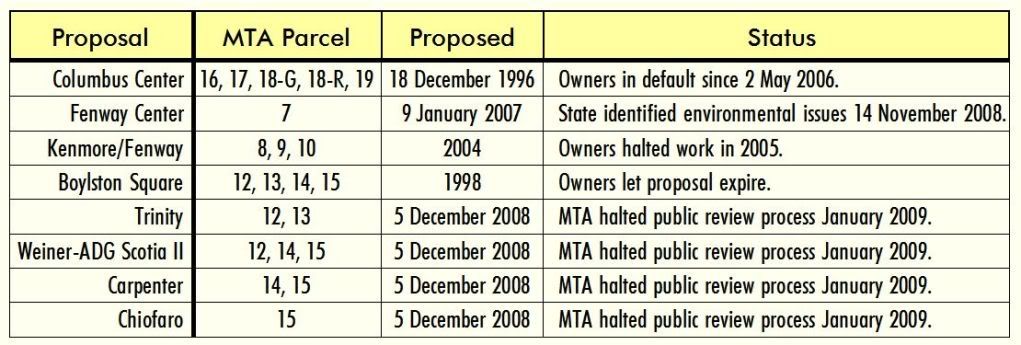stellarfun
Senior Member
- Joined
- Dec 28, 2006
- Messages
- 5,711
- Reaction score
- 1,544
Re: Columbus Center
A.) You are obfuscating. No one disputes that thousands of studies of particulates exist, but studies devoted exclusively to UFP are still few and far between. And a study of coarse or fine particulates cannot be extrapolated as covering UFPs as well. So your persistent claim of thousands of studies on UFPs is hokum.
B.) You have embellished your crusade against Columbus Center, and by extension the Turnpike Authority and the MBTA, by invoking the spectre of UFPs. I believe you have done so because UFPs, unlike the larger particulates, are neither currently regulated nor abated. One couldn't complain that Columbus Center would further pollute the environment when the sources of pollution in the immediate area are already being regulated. Columbus Center can't effectively address a pollutant straw man; against what UFP standard does one gauge effect? And which is why you have proposed, in the absence of a standard, that Columbus Center, as a matter of course, massively scrub the air in the vicinity of your condo of UFPs emitted by cars, trucks, and buses traveling the Pike, and the MBTA's diesel trains.
C.) Given your extensive knowledge of the science of fine particles and ultrafine particles, and of the technology for abating the leveld of these two classes of particulates in the ambient air, approximately what percentage of UFP emissions do you think will be abated as a consequence of further controls of fine particulates? To make it simpler, you can confine the analysis to diesel engines.
D.) You have regularly cited the several UFP studies that have been done, and abatement strategies resulting from those. The studies and the strategies are concentrated in southern California. You persist in asserting that what's good for Covina is good for Clarendon St.
[A.]Untrue._ The thousands of studies I?ve referred to since 2007 cover all three sizes of particulate matter:_ coarse, fine, and ultrafine._ The older studies focus more on coarse and fine particles, and the newer ones more on ultrafine particles (UFPs)._ Those thousands of studies are found or referenced at the links I?ve provided multiple times._ No scientific or medical literature has been published that ?debunks? these studies.
[B.]You?re only bewildered because you don?t recall exactly what I said._ I?ve always recognized the differences between coarse, fine, and ultrafine particles, but all particulate matter is an outstanding issue ? in all three sizes ? at any air rights site in Boston.
[C.]Untrue._ I?ve always acknowledged that gradual, small improvements are occurring with fine particles._ But much more abatement of fine particles is possible, and much, much more abatement of ultrafine particles is possible, since there?s virtually no abatement now._ All in all, no one should be allowed to build anything that creates unnecessary, avoidable public health risks, and that?s what the latest Columbus Center and Fenway Center proposals would do, as currently written.
[D.]Untrue._ I never suggested that Massachusetts and California have the same weather._ In fact, I?ve always acknowledged just what the PM studies acknowledge:_ that location can affect the detailed statistics about who is affected, by which health risks, how soon, how badly, etcetera._ And that is one of the reasons that Massachusetts air rights developers now are required to quantify and mitigate the public health risks posed by their proposals.
A.) You are obfuscating. No one disputes that thousands of studies of particulates exist, but studies devoted exclusively to UFP are still few and far between. And a study of coarse or fine particulates cannot be extrapolated as covering UFPs as well. So your persistent claim of thousands of studies on UFPs is hokum.
B.) You have embellished your crusade against Columbus Center, and by extension the Turnpike Authority and the MBTA, by invoking the spectre of UFPs. I believe you have done so because UFPs, unlike the larger particulates, are neither currently regulated nor abated. One couldn't complain that Columbus Center would further pollute the environment when the sources of pollution in the immediate area are already being regulated. Columbus Center can't effectively address a pollutant straw man; against what UFP standard does one gauge effect? And which is why you have proposed, in the absence of a standard, that Columbus Center, as a matter of course, massively scrub the air in the vicinity of your condo of UFPs emitted by cars, trucks, and buses traveling the Pike, and the MBTA's diesel trains.
C.) Given your extensive knowledge of the science of fine particles and ultrafine particles, and of the technology for abating the leveld of these two classes of particulates in the ambient air, approximately what percentage of UFP emissions do you think will be abated as a consequence of further controls of fine particulates? To make it simpler, you can confine the analysis to diesel engines.
D.) You have regularly cited the several UFP studies that have been done, and abatement strategies resulting from those. The studies and the strategies are concentrated in southern California. You persist in asserting that what's good for Covina is good for Clarendon St.

